what percent of slaves came to the united states
/https://tf-cmsv2-smithsonianmag-media.s3.amazonaws.com/filer/71/42/71424d2d-631d-428c-b54f-0623594831ed/hergesheimer-map.png)
In September of 1861, the U.S. Coast Survey published a large map, approximately two feet by iii feet, titled a "Map showing the distribution of the slave population of the southern states of the U.s.." Based on the population statistics gathered in the 1860 Census, and certified by the superintendent of the Demography Role, the map depicted the percent of the population enslaved in each county. At a glance, the viewer could encounter the large-calibration patterns of the economic organization that kept nearly iv 1000000 people in bondage: slavery was concentrated forth the Chesapeake Bay and in eastern Virginia; along the South Carolina and Georgia coasts; in a crescent of lands in Georgia, Alabama and Mississippi; and most of all, in the Mississippi River Valley. With each county labeled with the exact percentage of people enslaved, the map demanded some closer examination.
The Coast Survey map of slavery was one of many maps drawn from data produced in 19th-century America. As historian Susan Schulten has shown, this particular map was created by a federal government bureau from statistics gathered by the Demography. Abraham Lincoln consulted it throughout the Civil War. A banner on the map proclaims that it was "sold for the benefit of the Sick and Wounded Soldiers of the U.S. Army." The data map was an instrument of government, every bit well every bit a new applied science for representing noesis.
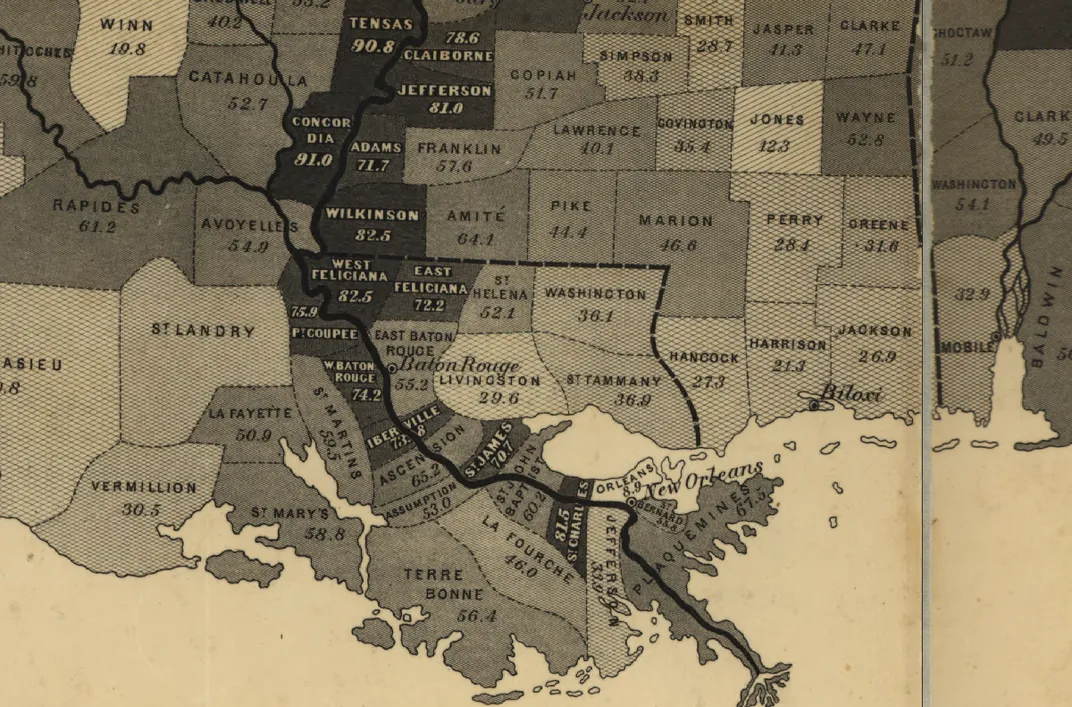
Though thematic mapping had its origins in the 19th century, the technique is useful for understanding history in our own 24-hour interval. One of the central bug of history is scale: how tin can historians move between understanding the past in terms of a single life and in the lives of millions; inside a city and at the bounds of continents; over a period of days and over the span of centuries? Maps can't tell usa everything, simply they tin can help, especially interactive spider web maps that tin zoom in and out, represent more than i subject, and be set in movement to show change over time.
To help bear witness the large patterns of American slavery, I have created an interactive map of the spread of slavery. Where the Coast Survey map showed one measure out, the interactive map shows the population of slaves, of free African Americans, of all free people, and of the unabridged United States, too as each of those mensurate in terms of population density and the percentage of the total population. The map extends from the first Census in 1790 to the Census taken in 1860 on the eve of the Ceremonious War. You tin explore the map for yourself, simply below I have created animations to highlight some of the major patterns.
When looking at all of these maps together, it's noticable that even as the total number of enslaved peoples in the The states increased between 1790 and 1860, the multitudes were dispersed across the increasing expanse of the Us, rather than becoming more concentrated in areas where slavery was well established.
In counties along the Atlantic Coast in 1790 and 1800, the population of slaves at any in one case was nearly at its peak. (This is all the more remarkable since many slaves fled to the British during the Revolutionary War.) Take for example, Charleston County, S Carolina. In 1790, almost 51,000 people were enslaved in that county. In 1840, the slave population reached its acme of most 59,000 people; by 1860, there were 37,000 enslaved people, just 63 pct every bit many slaves equally two decades earlier.
The full number of slaves in the eastern seaboard states did, however, grow slowly over time, but not at anything like the rate of growth for free people in the North. The free white population in the North grew in already settled places and spread to the Due west.
The slave population had a dissimilar dynamic. It grew in intensity in places around the Chesapeake Bay, even as slavery was gradually abolished in the North. Just for the nearly function the slave population spread w to the lands opened for settlement by the Louisiana Purchase, the dispossession of the Indian nations of the Southeast, the war with Mexico, and the distribution of public lands. Slavery spread rather than grew because it was an agronomical rather than industrial grade of capitalism, so it needed new lands.
And slavery spread because enslaved African Americans were forced to migrate. Historian Steven Deyle estimates "that between 1820 and 1860 at least 875,000 American slaves were forcibly removed from the Upper Southward to the Lower South." A minority of that migration happened considering white planters migrated forth with the people that they owned. Simply Deyle writes that "between 60 and 70 percent of these individuals were transported via the interregional slave trade." In other words, slavery was not the paternalist institution that its apologists made it out to be: information technology was an relentlessly exploitative system where the fundamental relation of owner to enslaved was defined past the markets. The unceasing spread of slavery provoked political crises, eventually leading to the Civil War. As Abraham Lincoln put it in is 1858 "Firm Divided" speech:
"Either the opponents of slavery, will arrest the further spread of it, and place it where the public mind shall balance in the conventionalities that information technology is in the course of ultimate extinction; or its advocates will push it forward, till it shall become alike lawful in all the States, old as well equally new, Northward as well every bit South."
Below you tin can meet 2 animations comparing the density of the slave population and the density of the total population (go on in listen that the scales are different).
This animation of the density of slave population from 1790 to 1860 shows how slavery expanded more than information technology grew.
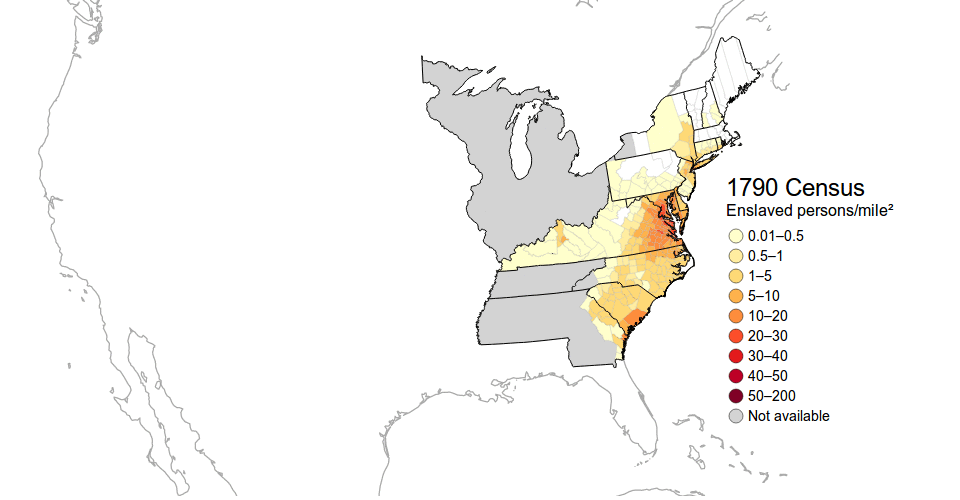
An animation of density of the total population from 1790 to 1860. Notice that population in the north both grows in identify and spreads westward.
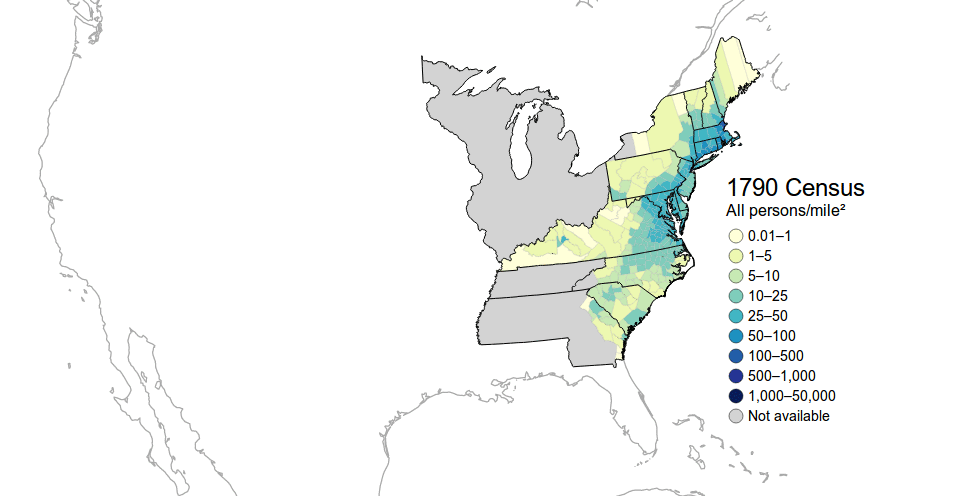
A 2nd observation to make from this map is how pervasive slavery was to the United States. In the beginning decades of the early on republic, the northern states had a meaning population of slaves, which simply slowly diminished through gradual emancipation laws. In the Southward, the percent of the population that was enslaved was extraordinarily high: over 70 pct in most counties along the Mississippi River and parts of the South Carolina and Georgia coast.
This animation shows the percentage of the population enslaved from 1790 to 1860.
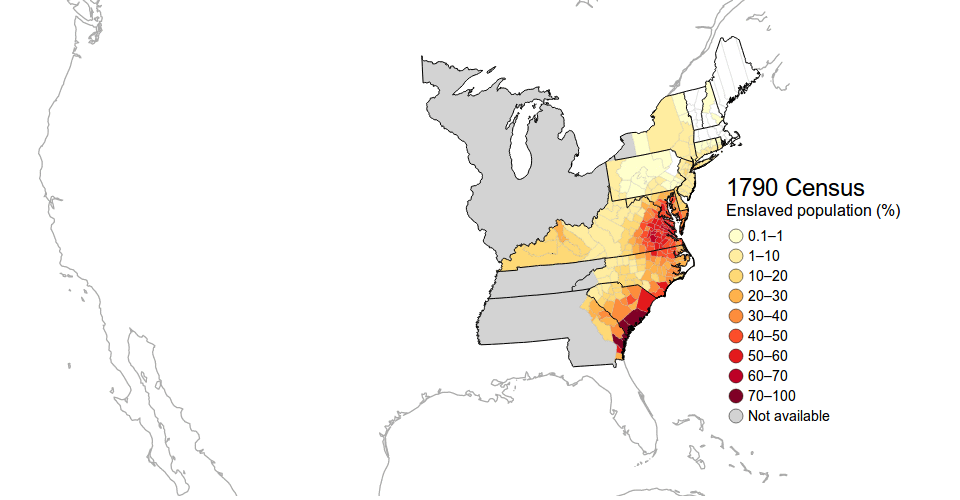
A striking style to see the importance of slavery is to await at a map of the full gratuitous population: a photo negative, if yous will, of slavery. When looking at the population density of all gratis persons (below in 1860), large swathes of the South appear about depopulated.
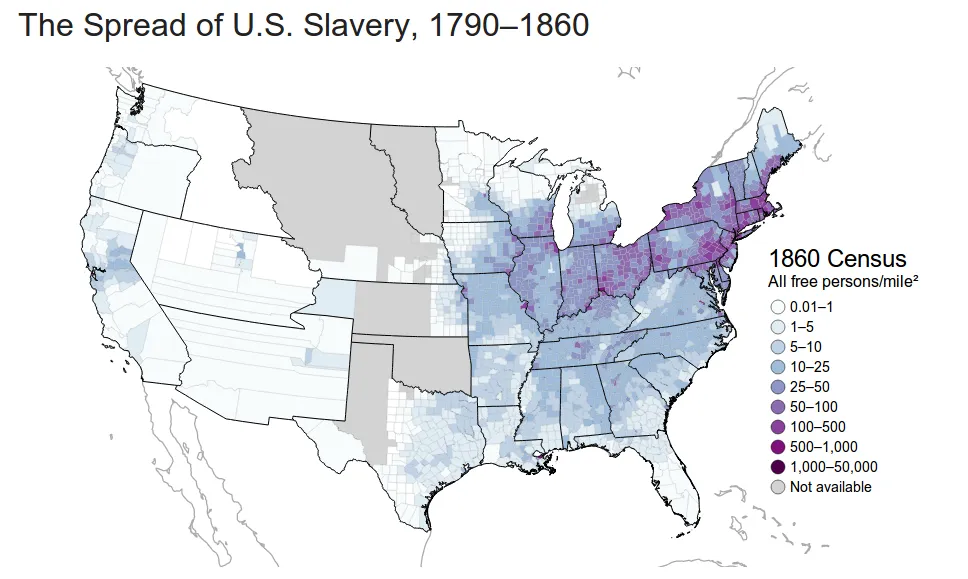
Finally, the dynamics of the gratis African American population looked more similar the free white population than the slave population. The complimentary African American population settled primarily forth the Eastern seaboard and especially in the cities of the northern United States. Gratuitous African Americans were virtually entirely excluded, in part by an extensive organisation of patrols, from the majority slave populations of the Deep South. This animation shows the complimentary African American population from 1790 to 1860.
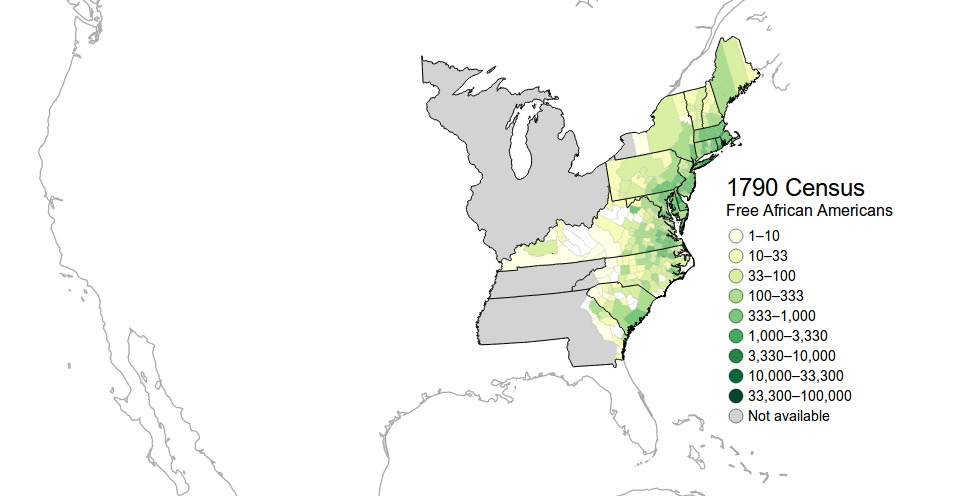
This interactive map and the Census data on which information technology is based can hardly testify almost of what should exist known about slavery. For example, the Census did not count any slaves in Vermont, which abolished slavery in its 1777 constitution. But Harvey Amani Whitfield has shown that some Vermont African Americans were held in bondage. Nor can these maps express anything of the pain of the whip or the escape to freedom, of the burnout of labor or the sounds of preaching and shouting at a religious gathering: for that one must read whatsoever of scores of excellent histories. Just they do requite a large overview of the forced labor organization which fabricated the nation "half slave and one-half free."
Sources
Susan Schulten, Mapping the Nation: History and Cartography in Nineteenth-Century America (Chicago: University of Chicago Press, 2012), writes about maps of slavery in affiliate 4; meet also the book's companion website which offers images of maps of slavery. Steven Deyle has written a recent history of the domestic slave merchandise in Comport Me Dorsum: The Domestic Slave Trade in American Life (New York: Oxford University Press, 2005); the figures cited in a higher place are from page 289. Of the many first-class histories of American slavery, come across i of these: on the settlement of the Mississippi River valley, Walter Johnson, River of Dark Dreams: Slavery and Empire in the Cotton Kingdom (Cambridge, Belknap Press of Harvard University Press, 2013); on the life of slaves, Erskine Clarke, Dwelling Place: A Plantation Epic (New Oasis: Yale University Press, 2005); on the history of slavery mostly, Ira Berlin, Generations of Captivity: A History of African-American Slaves (Cambridge, MA: Belknap Printing of Harvard Academy Press, 2003).
The data in my maps is fatigued from the 1790 to 1860 Censuses compiled by the Minnesota Population Center, [National Historical Geographic Information System], version 2.0 (Minneapolis: University of Minnesota, 2011).
U.S. Coast Survey, Map showing the distribution of the slave population of the southern states of the United states (Washington, DC: Henry S. Graham, 1861). Prototype from the Library of Congress.
morenodozedilitry.blogspot.com
Source: https://www.smithsonianmag.com/history/maps-reveal-slavery-expanded-across-united-states-180951452/
0 Response to "what percent of slaves came to the united states"
Post a Comment